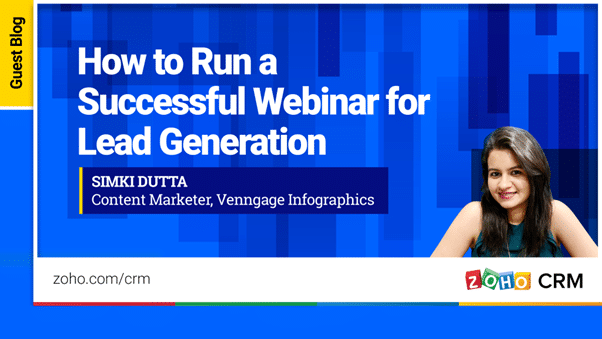Are you tired of the same old marketing tactics that aren’t giving your SaaS business the results it needs? Well, there’s good news. Webinar Lead Generation, one of the hottest content marketing trends, might just be the solution you’ve been looking for.
Yes, webinars – those online events that can make you feel like you’re back in school, but without the annoying homework.
If you’re a SaaS business owner or marketer, you might be wondering if webinars are worth the effort. The short answer is “absolutely.” Webinars can be one of the most effective tools in your sales and marketing arsenal.
So sit tight, get ready to learn how to leverage webinars for SaaS growth!
1. Building Brand Awareness Via Webinar Lead Generation
Hosting webinars may be an excellent approach to increase brand awareness for your SaaS business. In fact, 58% of marketers use webinars as a promotion tool.
By providing relevant information to your audience, you can establish your company as an industry authority and gain the trust of potential clients.
Begin by promoting your webinar using your existing marketing channels, such as email and social media. Consider partnering with other companies or industry leaders to expand your reach.

Make sure your promotional materials are eye-catching and accurately communicate the benefits of attending your webinar. Consider offering participants a one-of-a-kind promotion or incentive, such as a discount on your SaaS product or a free trial.
Finally, remember to follow up with your audience after the webinar to continue the dialogue and build partnerships. You may effectively sell your webinars while also building brand recognition with these strategies.
2. Webinar Lead Generation
Webinar lead generation may be an effective way to generate high-quality leads for your SaaS business. In fact, 73% of marketers believe that webinars are the best way to drive high quality leads.
By giving useful knowledge to your audience, you may attract new customers and establish your organization as an expert in your industry.
To engage visitors throughout your webinar, use best practices such as graphics, story, and interactive components such as polls or quizzes. Address pain points and offer solutions that work with your SaaS offering.

Following the webinar lead generation, send a tailored email thanking attendees and providing relevant documents such as a white paper or a free trial of your product. You may also try organizing a sales call or consultation with your leads to improve your relationship.
By employing these strategies, you can generate high-quality leads and establish long-term relationships with potential customers.
3. Revenue Generation
Webinars can be an effective sales tool for your SaaS company, allowing you to demonstrate your product and convert leads into paying clients. Be sure to properly define the benefits of your product and give a unique promotion or incentive for attendees, such as a discount or a free trial, to create a compelling offer during your webinar.
Make it simple for attendees to buy your goods by incorporating a link to your sales website or a call-to-action in your follow-up emails. Also, track data such as attendance rates, conversion rates, and client lifetime value to determine the impact of your webinars on revenue growth.
This data will help you refine your webinar approach over time and maximize your webinar’s income potential. You may achieve considerable revenue growth for your SaaS firm by employing the best webinar software for your sales campaign and developing engaging offers.
4. Customer Retention and Education
Webinars can play an important role in your business’s ABM strategy by educating your customers about your SaaS product and keeping them engaged over time. By offering regular webinars that provide value-added content, you can build stronger relationships with your customers and establish your business as a trusted resource in your industry.
Include subjects that are relevant to your clients’ problems and address typical inquiries or concerns about your product. Consider using webinars to elicit consumer feedback and recommendations for new features or product updates. Over time, you may find areas for development and refine your webinar strategy by monitoring the impact of your webinars on client satisfaction and retention.
Overall, using webinars as a tool for customer education and engagement is effective to enhance your relationships with your customers and boost retention over time.
5. Networking and Partnership Opportunities
Webinar lead generation may be a very effective strategy for generating networking and partnership opportunities for your SaaS company. By offering webinars that attract potential partners or industry influencers, you can build relationships that can lead to future collaborations or partnerships.
To capitalize on these possibilities, provide high-quality material that highlights your organization’s expertise and presents your company as an industry leader. You may also utilize webinars to interact with other firms or industry leaders, providing chances for networking and partnership.
You may enhance your exposure and position your company as a trusted resource in your market by using webinars to form relationships with potential partners and influencers.
How to Create Compelling Webinar Content
Whether your aim is to generate leads, raise revenue, or improve customer retention, creating captivating webinar content is important to the success of your webinar and reaching your goals. It’s crucial to remember that various goals necessitate different content tactics.
For example, if lead generation is your aim, you should concentrate on providing informative content that tackles your target audience’s problem areas and offers resolutions. If your objective is to generate revenue, on the other hand, you’ll want to design material that highlights the unique benefits of your product and gives compelling incentives for attendees to make a purchase.
You may also combine your objectives from the several categories listed above and tailor your content accordingly. For instance, you might build a webinar that focuses on both lead generation and customer engagement, giving value-added information that promotes your company as a recognized authority in your field while simultaneously driving new leads into your sales funnel.
You can build more appealing and successful webinars that provide results for your SaaS brand by adapting your content approach to your unique goals.
Tips and Best Practices to Tailor Webinars for SaaS Growth
Creating great webinar content is vital to the success of your SaaS company, but in order to fully optimize your results, you must personalize your content approach to your specific objectives.
There are a few important best practices that may help you develop more captivating and successful webinar content that connects with your target audience, whether you’re aiming to generate leads, raise revenue, enhance client retention, or build relationships.
-
Understand your audience
Take the time to research and understand your target audience before you begin developing your webinar content. What are their problems and obstacles? What are they looking for in terms of solutions? Understanding your audience’s demands allows you to generate content that speaks directly to their interests while also positioning your company as a valued resource.
-
Define your goals
- An important step in generating good webinar content is to define your goals. When you start organizing your webinar, you should have a clear idea of what you want to accomplish.
- Are you attempting to create leads, enhance revenue, increase client retention, or form partnerships? Each of these objectives necessitates a distinct content approach.
-
Choose the right format
Choosing the appropriate format is critical when it comes to delivering captivating webinar content. Webinars can take various forms, including panel discussions, product demonstrations, and expert interviews.
By selecting the appropriate format, you can establish your brand as a thought leader, showcase a new product or service, or educate your audience on a specific topic. Take note that it also is critical to choose a format that corresponds with your objectives and connects with your intended audience.
-
Keep it engaging
It is critical to employ a variety of multimedia elements such as slides, videos, and live polls to keep your audience interested during a webinar. Live Q&A sessions, surveys, and interactive conversations are other successful methods of encouraging involvement and keeping participants interested.
With a variety of these components, you can keep your audience engaged and interactive during your webinar, resulting in a more interesting and memorable experience for your visitors.
-
Use storytelling
Integrating narrative into webinar material may be a powerful approach to emotionally connect and affect the audience. To establish connection with the audience and create a sense of shared experience, begin with a personal anecdote that emphasizes the webinar’s main theme.
Utilizing case studies and real-life examples to demonstrate essential topics may also help to make information more relevant, practical, and give participants with valuable recommendations. To keep the audience interested throughout the presentation, the webinar’s content structure should generate momentum and progression, delivering a cohesive and captivating story.
Tailoring your webinar content to your unique goals is a critical component of delivering successful and profitable webinars for your SaaS business.
Understanding your audience, establishing your goals, selecting the correct format, keeping it interesting, and leveraging storytelling will help you develop more compelling and successful webinar material that resonates with your target audience and delivers results for your organization.
Key Takeaways for Leveraging Webinars for SaaS Growth
In conclusion, webinars are a great tool for SaaS growth. Whether you’re building a vertical or horizontal SaaS, webinars can really help you with growing your audience and customer base.
Provide captivating content that highlights your expertise and provides value to your target audience to increase brand awareness. Engage guests by promoting participation and giving clear calls-to-action to help you generate high quality leads. To increase your conversion rate, follow up with webinar leads in a timely and customized manner.
Focus on providing engaging offers that connect with your product or service offerings during your webinars to generate revenue. To measure the efficacy of your webinars, track their influence on revenue growth.
Use webinars to keep your customers interested and educated about your product or service to improve your customer retention and education. To guarantee your clients are getting the most out of your offering, use webinars to educate them on product upgrades, new features, and best practices.
Lastly, webinars may be a wonderful approach to create industry collaborations and networks. Webinars allow you to showcase your skills while also building contacts with potential partners.
Remember to adapt your webinar material to your unique aims and audience, and to keep your guests interested, use narrative and multimedia features. Overall, including webinars into your marketing approach may be an efficient method to achieve a variety of business objectives if you’re wanting to expand your SaaS firm.


